List of Authors
>>About this blog
Recent blog post
|
[Shitamachi Tom]
December 22, 2014 13:00
This year will be over soon. The flow of the year is fast. Chuo-ku is a commercial town, so this season is exactly the time of writing, such as shops and department stores. It's full of shoppers to prepare for New Year's Day.
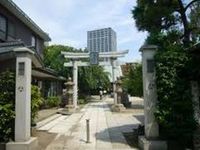 On the other hand, many shrines in the ward have a ritual called "great exorcism" on New Year's Eve. It has been practiced since ancient times as an important event to purify the filth of the year and pray for the well-being of the coming year. Even if it is not a religion, it will be a peace of mind for a moment in the sense that you reflect on your own failures and inadequate events of the year, forget what you do not like and think about the new year. Do you? On the other hand, many shrines in the ward have a ritual called "great exorcism" on New Year's Eve. It has been practiced since ancient times as an important event to purify the filth of the year and pray for the well-being of the coming year. Even if it is not a religion, it will be a peace of mind for a moment in the sense that you reflect on your own failures and inadequate events of the year, forget what you do not like and think about the new year. Do you?
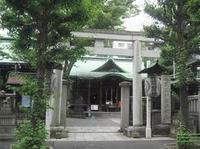 You can visit each local shrine, or visit a shrine that is concerned about going back and forth for shopping. You can visit each local shrine, or visit a shrine that is concerned about going back and forth for shopping.
There are also routes in Chuo-ku where you can enjoy cultural and history and walking at the same time, such as "Nihonbashi Seven Lucky Gods" and "Ginza Hachisha Tour", so it is recommended that you visit as a stroll on holidays during the year-end and New Year holidays.
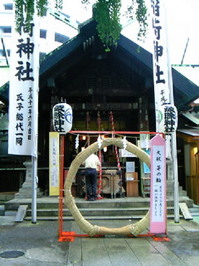 Then, if you come to Tsukiji Market to buy ingredients for New Year's cuisine, please drop in at [Namishi Inari Shrine]. From mid-month to January 10, "Chinowa" is installed in front of main hall. You can go through this ring to remove trouble. Why don't you make a New Year's pledge? Then, if you come to Tsukiji Market to buy ingredients for New Year's cuisine, please drop in at [Namishi Inari Shrine]. From mid-month to January 10, "Chinowa" is installed in front of main hall. You can go through this ring to remove trouble. Why don't you make a New Year's pledge?
Even if you don't usually go to shrines, many people go to "new year worshipping" on New Year's Day. I asked a certain person, but it seems that it is not good to ask God for various things realistically. Rather, it seems meaningful to look back on his vows, reflections, and gratitude in front of God. Depending on that attitude, there is also God's protection. So it would be quite nice to look back on the year quietly in the precincts that are not so crowded at the end of the year.
I hope that next year will be a better year for you.
Thank you very much for your continued support this year.
[Silver]
December 22, 2014 09:00
At the end of the year, you can hear Santa Clause is coming to town.
Tsukiji Foreign Settlement was established in the current Akashicho area in 1868 (1868).
Since then, the settlement has been built with Western architecture schools , hospitals , hospitals , churches, and residence , churches, and residence s, and this area has become a window for Western culture. s, and this area has become a window for Western culture.
With the amendment of the treaty in 1899 (1899), the settlement of Tsukiji was abolished as well as other settlements. There is an explanatory version describing the origin of the site. ・・ ・ I think this is an explanatory version in front of the St. Luke's Tower.
The above explanation was a part of the Chuo-ku Tourism Certification.
In Akashicho, there are many birthplaces of mission schools.
Today, I heard the Melo Day of Jingle Bell, so I visited the Catholic Tsukiji Church Cathedral. of Jingle Bell, so I visited the Catholic Tsukiji Church Cathedral.
The Catholic Tsukiji Church Cathedral was built in 1874 (1874) as the second Christian church following Nagasaki and Yokohama in the Tsukiji Foreign Settlement.
The cathedral was built in 1878, but it was burned down in the Great Kanto Earthquake, so this building was built in 1927 (1927) after the Taisho Earthquake.
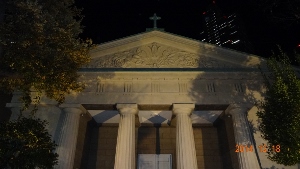
According to the introduction board of the Tokyo Metropolitan Cultural Properties, the Tokyo Metropolitan Government
This building was designed by Father Jirodias, Onjiro Ishikawa, a evangelist, and is a beautiful building in Yumi.
There are six Doria-style pillars, and the gable wall in front of the roof has sculptures  of roses and tulips. of roses and tulips.
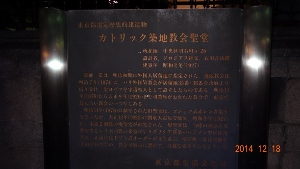
In addition, according to explanation version of Chuo-ku Board of Education, we understand the details again.
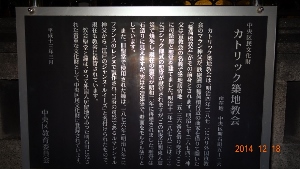
In the past, when I saw the interior of the church, there was a copper bell cast in France, which was designated as the central ward Tangible Cultural Property.
How about visiting a peaceful church during the busy hours of the end of the year?
Wishing you a Merry Christmas and a Happy New Year. 
Feliz Natal e prospero ano novo. Happy New Year.
[Mr.Chuo-ku]
December 19, 2014 15:00
Founded in 1899, Yoshinoya's founding store (the first store) is located in the central wholesale market food in Tsukiji, Chuo-ku, with approximately 1,800 stores in Japan and overseas as the largest beef bowl chain.
※↓Click to enlarge each photo and image.
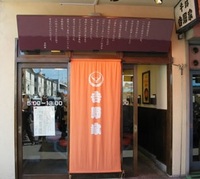
①Company name is Yoshinoya Co., Ltd. (English name: YOSHINOYA CO., LTD.)
※The character of Yoshi is correctly "soil" and "mouth".
②Founded in Nihonbashi Fish Bank, Chuo-ku

③The menu at the first store is only beef bowl, beef plate, and familiar side dishes such as miso soup and egg.

(1 company name, 2 photos, and 3 menu are excerpted from the official website.)
The following is a story I've heard.
The meat used at this first store is Japanese beef. Onion is also fresh and soft, and here Tsukiji is a place where "fresh ingredients" and "food professionals" gather, and you are also particular about beef bowls.
Also, at the time of ordering, options such as `` Negidaku '' and `` Tsuyudaku '' are all Yoshinoya, but at the first store, the degree varies depending on how many times you say `` dakudakudaku '' such as `` Negidakudaku '' and `` Tsuyudakudaku '' It seems to be. In addition, there are also "tsumeshiro (cold rice)" and "torodaku (a lot of meat fat)". The Tsukiji store, which was founded on the fish shore as Yoshinoya, seems to have special attention and has changed its stance from other stores.
Address: 5-2-1 Tsukiji, Chuo-ku, Tokyo Central Wholesale Market Food C
Business hours From 5:00 to 13:00
Regular holidays: In accordance with the Tsukiji Market
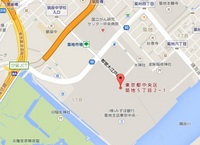
Official Homepage
Yoshinoya No. 1 store:
http://www.yoshinoya.com/shop/tsukiji/index.html
History of Yoshinoya:
http://www.yoshinoya.com/company/history.html
[Koedo Itabashi]
December 10, 2014 14:00
December 14, 2014.
This day will be the election day for the lower house of the Diet.
On the TV before the announcement, along with the video of the defeat of Nanji Akaho, he conveyed the rush of the New Year's election.
"Sometimes December 14, 1702" ...
"The night breeze of Edo resonates with the Yamaga style's Jin Taiko, and one hit two hit three streams."
Haruo Minami's feature-length song "Tawarasei Genban"
While I was an elementary school student, I learned about the crispness and dramatic scene development twice and three times, and it was useful at the neighborhood association's hidden arts and year-end parties.
Now, from time to time, I walk around the city while spreading the old maps of Edo, and walking around Chushingura is a royal road.
The journey from Honjo Matsuzaka-cho to Takanawa Sengakuji Temple in front of the grave of Naganori Asano is the Golden Route of Shiwasu.
At the time of repatriation, Akaho Nanji proceeded without lifting his arms.
After protecting yourself with a chainmail, armed with bows, spears, and naginata, and defeating in groups, you must prepare for the hunters from Kira Uenosuke's Minako Uesugi Tsunanori and the pursuit of public security forces.
The repatriation route in Chuo-ku begins with Eitai Bridge.
It was said that it was bridged about 150 meters upstream from the current location, so it will be around Sumida River Ohashi.
From Minato Bridge, go through Reigishi Island and Kamejima and cross Takahashi.
Beyond that was the Akaho Domain Kamiyashiki.
It is located around the current St. Luke's College of Nursing, Akashi Elementary School.
This is also the birthplace of Takumi Asanouchi, Naganori.
If you go further south, Tsukiji Honganji Temple. The cottages are lined up with rags.
One of the forty-seven men, Peace pagoda of Shinroku Hazama, remains.
During the withdrawal, it is reported that his memorial service was tied to a spear and thrown into a temple fence.
Go through Tsukiji Market and proceed from Showa-dori to Shiodome-dori to enter Minato-ku.
I've read and compared some books, but I don't really know the detailed route.
However, even after more than 300 years since 1702 and 1702, you can still look for traces of rivers and bridges.
It's also interesting to follow the Oedo incident over 300 years.
When I traveled to Kira Town in Aichi Prefecture, I saw a play of "Chushingura seen from the Kira side" by local people.
The spirit was interesting, and I was longing for a famous lord locally, and purchased the root of "Kira no Akaba" that I boarded during a tour of the territory.
[Sumida Fireworks]
December 10, 2014 09:00
This year was just 50 years since the Tokyo Olympics in 1964.
To commemorate that, events were held in various places, and special features were set up on TV programs, and something became a hot topic.
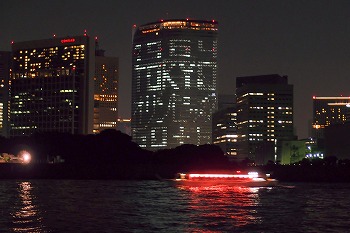 (Photo: October 11, 2014 Kachidoki, Chuo-ku, scenery of Shiodome on the opposite shore of Sumida River, 1964TOKYO Olympics 50th) (Photo: October 11, 2014 Kachidoki, Chuo-ku, scenery of Shiodome on the opposite shore of Sumida River, 1964TOKYO Olympics 50th)
In preparation for the Olympics, various transportation infrastructures such as Shinkansen, expressways, and monorails were being prepared.
In Chuo-ku, I think of the Metropolitan Expressway, which was built over Nihonbashi.
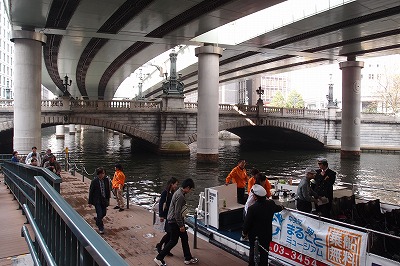 (Photo: Nihonbashi free cruise at the Marugoto Museum in Chuo-ku on November 2, 2014) (Photo: Nihonbashi free cruise at the Marugoto Museum in Chuo-ku on November 2, 2014)
Another other is the Tsukuda-ohashi Bridge, which was first bridged over the Sumida River after the war.
It wasn't very much taken up, though
Since it is opened in 1964, the same as the Olympics, this is also the 50th anniversary this year.
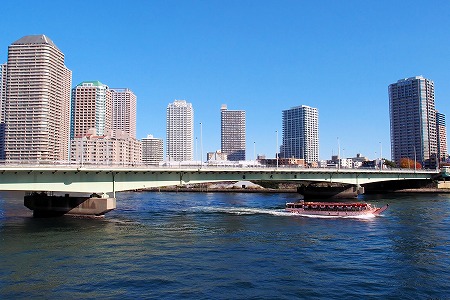 This time, I took up this bridge. This time, I took up this bridge.
This bridge connects Tsukuda Island and Tsukishima with Akashicho and central Tokyo, but it cannot be said that it has a very big feature in its appearance and shape.
However, in order to meet the Olympics, the bridge work was carried out at a rapid pace by combining the technologies of the time.
It can be said to be a symbol of Japan's high economic growth period when this bridge was built.
Before this bridge was built, the ship of Tsukuda's ferry, which was located at the same position as the bridge, was a citizen's foot.
It seems that this ferry was abolished at the same time as the opening of the bridge (August 27, 1964).
You can search for old images on the website of the Chuo City Library, but when I searched, I was able to find valuable photos from that time.
Link ⇒ Open Tsukuda-ohashi Bridge
This ferry on Tsukuda Island dates back to the rowing ferry in the early Edo period that connects Tsukuda Island and the city of Edo.
It was an event that ended with a history of 320 years.
Link ⇒ Ferry on Tsukuda Island
Many new historys have been created by the Olympics.
On the other hand, there were many things that were lost?
I looked for the remnants of this ferry around Tsukuda-ohashi Bridge.
The first is the monument of Tsukuda Island ferry on both banks of the Sumida River where the ferry was located.
 There are various changes in the ferry itself, but this monument was built in 1927 when the fare of the ferry operated by Tokyo City at the time became free. There are various changes in the ferry itself, but this monument was built in 1927 when the fare of the ferry operated by Tokyo City at the time became free.
The other is the "Lighthouse of Ishikawajima and the scenery of Tsukuda handing over" carved in the ranma of the basin (Omizuya) in Tsukuda Island and Sumiyoshi-jinja Shirine.
 If you are purifying your hand in the basin when you visit Sumiyoshi-jinja Shirine, please take a look at the top. If you are purifying your hand in the basin when you visit Sumiyoshi-jinja Shirine, please take a look at the top.
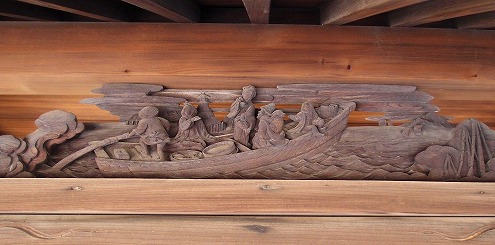 Each of the four sides of this building has sculptures related to different Tsukuda Island, one of which is "Ishikawajima Lighthouse and Tsukuda Passing Landscape". Each of the four sides of this building has sculptures related to different Tsukuda Island, one of which is "Ishikawajima Lighthouse and Tsukuda Passing Landscape".
It seems to have been carved in the Meiji era.
By the way, over the past 50 years, the environment and landscape around this bridge have changed, and the landscape from this bridge has changed every moment.
This Hashigami has an excellent sense of openness, so it has a good view and you can worship a very good landscape.
You can see the scenery of Chuo-ohashi Bridge and the Sky Tree in the upper reaches of the Sumida River.
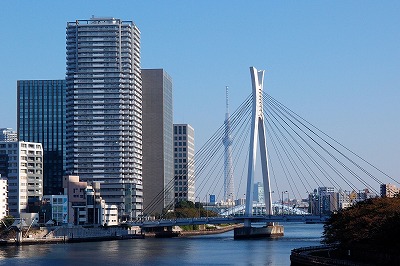 Of course, you can also see the streets of Tsukuda and the apartments in River City. Of course, you can also see the streets of Tsukuda and the apartments in River City.
And there are three arch bridges in the downstream area?
A new view has been added recently.
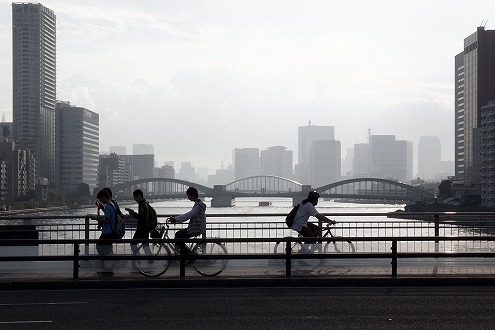 One arch of "Tsukiji Ohashi" formed at the lowermost stream of the Sumida River and two arches of "Kachidokibashi" in the foreground. One arch of "Tsukiji Ohashi" formed at the lowermost stream of the Sumida River and two arches of "Kachidokibashi" in the foreground.
There is a place on Tsukuda-ohashi Bridge that is similar in size and does not seem to overlap.
Did the people at the time of 1964 imagine the current landscape 50 years from now?
I can't imagine what the scenery will change in 50 years, but I hope that the good old scenes of Japan will remain.
[Nojinya]
December 9, 2014 14:00
The morning drama "Massan" modeled on the father of Japanese whiskey Masataka Taketsuru and Rita is very popular. I'm looking forward to seeing it every day, but today I would like to introduce Asa Dora's "Himi" (broadcast in 2008) set in Tsukishima and Tsukuda.
Hitomi Ippongi (20 years old), who plays the theme song by trombone player Eijiro Nakagawa and the opening of the bird's-eye view of Tsukuda and Tsukishima, is the main character Hitomi Ippongi (20 years old), who plays Nana Eikura, who aims to become a hip-hop dancer in Sapporo, started with her mother's Momoko, and she went to Tokyo for the funeral for the first time with her grandfather. My grandfather, Katsutaro, is a foster parent (Tokyo's nursing home system:
http://www.fukushihoken.metro.tokyo.jp/kodomo/satooya/seido/hotfamily/index.html)
He raises three foster children, led by junior high school students, but his eyes go to a dance school in Shibuya while living at his grandfather's home in Tsukishima as a young foster parent instead of his deceased grandmother.
The eyes, who looked at the balance between foster parents and dance, communicated with his grandfather Katsutaro and Satoko, and grew up with the support of the people of Tsukishima, despite various small incidents. On the other hand, at the dance school, dance aims to win the tournament by forming a unit with strong friends while dancing. 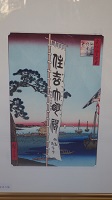 At the end of the tournament, the unit was dissolved, and the eyes that were attacked by a sense of weakness had grown their eyes with one woman while working at a cosmetics company until now, and now they have been transferred to the Tokyo branch office and work for a men and women of all ages. One day, a father who divorced Momoko with his grandfather Katsutaro appears in Sumiyoshi-jinja Shirine. 。 。 From the 25th week, the summer of Keijime, to the 26th week (final week), in the festival town, the drama is finally climaxing with the excavating a large banner, assembling the Sennuki Mikoshi, and the scene toward the day of Sumiyoshi-jinja Shirine Reitaisai festival. At the end of the tournament, the unit was dissolved, and the eyes that were attacked by a sense of weakness had grown their eyes with one woman while working at a cosmetics company until now, and now they have been transferred to the Tokyo branch office and work for a men and women of all ages. One day, a father who divorced Momoko with his grandfather Katsutaro appears in Sumiyoshi-jinja Shirine. 。 。 From the 25th week, the summer of Keijime, to the 26th week (final week), in the festival town, the drama is finally climaxing with the excavating a large banner, assembling the Sennuki Mikoshi, and the scene toward the day of Sumiyoshi-jinja Shirine Reitaisai festival.
[Sumiyoshi-jinja Shirine Grand Festival Large Nobori: Exhibited at Tsukuda Machikado Exhibition Hall]
In fact, unfortunately, the audience rating of "Eye" was quite low among NHK's past morning dramas, and it seems that it was a work that was very popular in the media and the Internet at the time of broadcasting. Although it is a personal impression, as a drama broadcast during the busy hours of morning such as going to work or going to school, it deals with slightly heavy topics such as foster parents and divorce of parents and rehabilitation, and slowly watch TV It may be the reason that the hurdles for viewers have been raised by the fact that hip-hop, which seems to be somewhat difficult to gain understanding for seniors who can watch. I enjoyed talking while drinking beer slowly at night, but it is recommended that this drama be relaxed and watched slowly. It's a total of 156 times, so don't let me know!
[New Year scenery of Sumiyoshi-jinja Shirine]
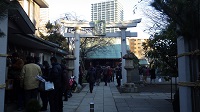
A lot of highlights of Chuo-ku appear in "Himi" set in Tsukishima and Tsukuda, where the atmosphere and human relationships of the downtown area remain strong. Katsutaro's Ippongi Western Shop and Tsukishima's alley scenery on Monja Street in Tsukishima where the eyes live, Chuo-ohashi Bridge and the eyes practice dancing, the Paris Square in Tsukuda where the eyes practice dancing, Sumiyoshi-jinja Shirine to Kachidokibashi, and Tsukiji Market. In addition, Tsukishima Minami Junior High School (without realism), which is set to go to Satoko's children, seems to have been filmed at Tsukuda Junior High School (Tsukuda 2-chome). The Reitaisai festival, including the imperial procession Funatogyo, can be seen in the drama, so I recommend it especially during the 25th and 26th week (Vol. 13 in DVD) . It seems that it has not been uploaded on NHK's on-demand, but it can be enjoyed on DVDs released by NHK Enterprises (some rentals are also available).
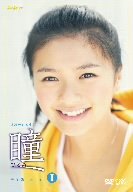
[The Eye] Released from DVD NHK Enterprises
|
Links
|
 On the other hand, many shrines in the ward have a ritual called "great exorcism" on New Year's Eve. It has been practiced since ancient times as an important event to purify the filth of the year and pray for the well-being of the coming year. Even if it is not a religion, it will be a peace of mind for a moment in the sense that you reflect on your own failures and inadequate events of the year, forget what you do not like and think about the new year. Do you?
On the other hand, many shrines in the ward have a ritual called "great exorcism" on New Year's Eve. It has been practiced since ancient times as an important event to purify the filth of the year and pray for the well-being of the coming year. Even if it is not a religion, it will be a peace of mind for a moment in the sense that you reflect on your own failures and inadequate events of the year, forget what you do not like and think about the new year. Do you? You can visit each local shrine, or visit a shrine that is concerned about going back and forth for shopping.
You can visit each local shrine, or visit a shrine that is concerned about going back and forth for shopping. Then, if you come to Tsukiji Market to buy ingredients for New Year's cuisine, please drop in at [Namishi Inari Shrine]. From mid-month to January 10, "Chinowa" is installed in front of main hall. You can go through this ring to remove trouble. Why don't you make a New Year's pledge?
Then, if you come to Tsukiji Market to buy ingredients for New Year's cuisine, please drop in at [Namishi Inari Shrine]. From mid-month to January 10, "Chinowa" is installed in front of main hall. You can go through this ring to remove trouble. Why don't you make a New Year's pledge?






 (Photo: October 11, 2014 Kachidoki, Chuo-ku, scenery of Shiodome on the opposite shore of Sumida River, 1964TOKYO Olympics 50th)
(Photo: October 11, 2014 Kachidoki, Chuo-ku, scenery of Shiodome on the opposite shore of Sumida River, 1964TOKYO Olympics 50th) (Photo: Nihonbashi free cruise at the Marugoto Museum in Chuo-ku on November 2, 2014)
(Photo: Nihonbashi free cruise at the Marugoto Museum in Chuo-ku on November 2, 2014) This time, I took up this bridge.
This time, I took up this bridge. There are various changes in the ferry itself, but this monument was built in 1927 when the fare of the ferry operated by Tokyo City at the time became free.
There are various changes in the ferry itself, but this monument was built in 1927 when the fare of the ferry operated by Tokyo City at the time became free.
 Each of the four sides of this building has sculptures related to different Tsukuda Island, one of which is "Ishikawajima Lighthouse and Tsukuda Passing Landscape".
Each of the four sides of this building has sculptures related to different Tsukuda Island, one of which is "Ishikawajima Lighthouse and Tsukuda Passing Landscape". Of course, you can also see the streets of Tsukuda and the apartments in River City.
Of course, you can also see the streets of Tsukuda and the apartments in River City. One arch of "Tsukiji Ohashi" formed at the lowermost stream of the Sumida River and two arches of "Kachidokibashi" in the foreground.
One arch of "Tsukiji Ohashi" formed at the lowermost stream of the Sumida River and two arches of "Kachidokibashi" in the foreground.

